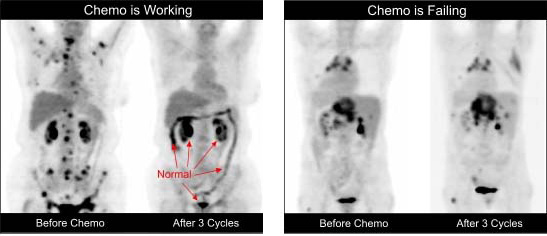PET/CT has applications for some but not all types of cancers. It is most commonly used for:
- Breast Cancer
- Lymphoma
- Lung Cancer
- Skin Cancer
- Colorectal Cancer
- Esophageal Cancer
- Thyroid Cancer
- Head & Neck Cancer
- Some Gynecologic Cancers
It is not used as often in:
- Prostate Cancer
- Brain Cancer
- Bladder Cancer
- Kidney Cancer
The Questions PET/CT Can Answer
For many types of cancer, PET/CT is not just for diagnosis. In fact, PET/CT can be used to guide your doctor through your treatment and it can be used to detect recurrence after treatment. The questions that PET/CT can provide answers to are:
- Diagnosis – Do I have cancer?
- Staging – How much has the cancer spread?
- Guiding Radiation Therapy – Where should the radiation be aimed?
- Response to Therapy – Is my therapy working?
- Re-Staging – Did my therapy work?
- Surveillance – Did my cancer come back?
It is common for a patient to have several PET/CT scans during the first 2 years after the initial diagnosis.
Diagnosis – Do I have cancer?
The “gold standard” for the diagnosis of cancer is a biopsy. For some types of cancer, it is fairly easy to do a biopsy, so PET/CT is usually not used. However, sometimes it is difficult to know where to do a biopsy, so PET/CT is used to guide the biopsy.
In the lung, biopsies are much more difficult to do, so PET/CT is typically used before a biopsy.
Staging – How much has the cancer spread?
Once cancer has been detected, the next step is to determine how much the cancer has spread. This is critical information, because it determines which therapies your doctor will use to treat the cancer. For example, if the cancer has not spread then it might be possible to remove the cancer surgically. However, if the cancer has spread, then surgery may not be a good choice, because it may not be possible to remove all of the cancer. In that case, chemotherapy might be more appropriate.
For many types of cancer PET/CT is the most powerful and accurate staging tool that we have. It can detect areas where the cancer has spread, 6 months to a year before it is detectable with the next best tool (CT – alone).
A staging scan is also useful to provide a baseline, if you doctor is going to use PET/CT later to measure the effectiveness of chemotherapy.
If PET/CT was used for diagnosis, then you will not need an additional scan for staging; the diagnostic scan can be used for staging.
Guiding Radiation Therapy – Where should the radiation be aimed?
For some types of cancer, your doctor may choose to treat the cancer with radiation. With radiation therapy, a very thin beam (like a pencil) beam of radiation is aimed at the tumor. This beam is moved so that it hits as much of the tumor as possible and misses as much of the normal tissue as possible.
PET/CT is the most accurate tool for determining where to aim the radiation. If you had PET/CT staging scan, then it might be possible to use this same scan for guiding radiation therapy.
Response to Therapy – Is my therapy working?
Because PET/CT makes images of function instead of anatomy, for some types of cancer it can determine if chemotherapy is working as early as one cycle in to therapy. There is no other imaging modality that can do this. If PET/CT shows that chemo is not working, then your doctor can change switch you to another type of chemo, very early in your treatment.

Re-Staging – Did my therapy work?
Re-staging is done after therapy has been completed. It is done to determine if the cancer is completely gone. For many types of cancer PET/CT is the most powerful and accurate re-staging tool that we have.
One of the challenges in determining if the cancer is gone is that after therapy, there can changes of the anatomy in the area of the tumor. Sometimes it is difficult to determine if an abnormality is residual tumor or if it is due to the changes in anatomy. Because PET/CT also measures function, PET/CT is the most accurate tool for making that distinction.
Surveillance – Did the cancer come back?
Surveillance might be done for several years after therapy has been completed. PET/CT is one of several tools that your doctor might use to determine if the cancer has come back. In some cases PET/CT is the first tool used. In other cases, PET/CT might only be used after there are some other signs that indicate that the cancer might be back.

